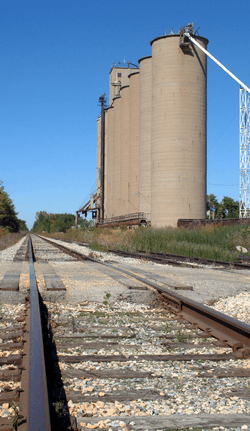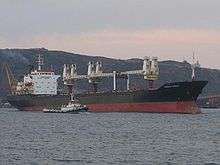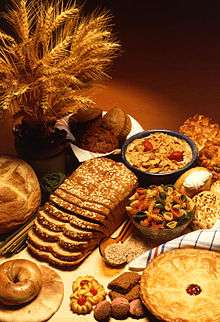Grain trade
The grain trade refers to the local and international trade in cereals and other food grains such as wheat, maize, and rice.
The complexity of the conditions of life in the 20th century may be well illustrated from the grain trade of the world. The ordinary bread sold in Great Britain represents, for example, produce of nearly every country in the world outside the tropics.[1]
History


The grain trade is probably nearly as old as grain growing, going back the Neolithic Revolution (around 11,500 BCE). Wherever there is a scarcity of land (e.g. cities), people must bring in food from outside to sustain themselves, either by force or by trade. However, many farmers throughout history (and today) have operated at the subsistence level, meaning they produce for household needs and have little leftover to trade. The goal for such farmers in not to specialize in one crop and grow a surplus of it, but rather to produce everything his family needs and become self-sufficient. Only in places and eras where production is geared towards producing a surplus for trade (commercial agriculture), does a major grain trade become possible.
Early trade was most likely by barter, and because hauling large amounts of grain around was difficult with ancient technology, the trade was probably quite limited in terms of the volume traded and the distance that grain was transported. The development of the money economy and the wheel would have facilitated a much more expansive trade.
In the ancient world, grain regularly flowed from the hinterlands to the cores of great empires: maize in ancient Mexico, rice in ancient China, and wheat and barley in the ancient Near East. With this came improving technologies for storing and transporting grains; the Hebrew Bible makes frequent mention of ancient Egypt's massive grain silos.
During the classical age, the unification of China and the pacification of the Mediterranean basin by the Roman Empire created vast regional markets in commodities at either end of Eurasia. The grain supply to the city of Rome was considered by be of the utmost strategic importance to Roman generals and politicians.
In Europe, with the collapse of the Roman system and the rise of feudalism, many farmers were reduced to a subsistence level, producing only enough to fulfill their obligation to their lord and the Church, with little for themselves, and even less for trading. The little that was traded was moved around locally at regular fairs.
A massive expansion in the grain trade occurred when Europeans were able to bring millions of square kilometers of new land under cultivation in the Americas, Russia, and Australia, an expansion starting in the fifteenth and lasting into the twentieth century. In addition, the consolidation of farmland in Britain and Eastern Europe, and the development of railways and the steamship shifted trade from local to more international patterns.
During this time, debate over tariffs and free trade in grain was fierce. Poor industrial workers relied on cheap bread for sustenance, but farmers wanted their government to create a higher local price to protect them from cheap foreign imports, with Britain's Corn Laws being an example.

As Britain and other European countries industrialized and urbanized, they became net importers of grain from the various breadbaskets of the world. In many parts of Europe, as serfdom was abolished, great estates were accompanied by many inefficient smallholdings, but in the newly colonized regions massive operations were available to not only great nobles, but also to the average farmer. In the United States and Canada, the Homestead Act and the Dominion Lands Act allowed pioneers on the western plains to gain tracts of 160 acres (0.65 km2) (1/4 of a square mile) or more for little or no fee. This moved grain growing, and hence trading, to a much more massive scale. Huge grain elevators were built to take in farmers' produce and move it out via the railways to port. Transportation costs were a major concern for farmers in remote regions, however, and any technology that allowed the easier movement of grain was of great assistance; meanwhile, farmers in Europe struggled to remain competitive while operating on a much smaller scale. From the 1911 Encyclopædia Britannica:
The farmers of the United States have met a greatly increased output from Canada, the cost of transport from that country to England being much the same as from the United States in the 20th century. So much improved is the position of the farmer in North America compared with what it was about 1870, that the transport companies in 1901 carried 171/4 bushels of his grain to the seaboard in exchange for the value of one bushel, whereas in 1867 he had to give up one bushel in every six in return for the service.
As regards the British farmer, it does not appear as if he had improved his position; for he has to send his wheat to greater distances, owing to the collapse of many country millers or their removal to the seaboard, while railway rates have fallen only to a very small extent; again the farmers wheat is worth only half of what it was formerly; it may be said that the British farmer has to give up one bushel in nine to the railway company for the purpose of transportation, whereas in the seventies he gave up one in eighteen only. Enough has been said to prove that the advantage of position claimed for the British farmer by Caird was somewhat illusory. Speaking broadly, the Kansas or Minnesota farmers wheat does not have to pay for carriage to Liverpool more than 2s. 6d. to 7s. 6d. per ton in excess of the rate paid by a Yorkshire farmer; this, it will be admitted, does not go very far towards enabling the latter to pay rent, tithes and rates and taxes.[1]

In the 1920s and 1930s, farmers in Australia and Canada reacted against the pricing power of the large grain-handling and shipping companies. Their governments created the Australian Wheat Board and the Canadian Wheat Board as monopsony marketing boards, buying all the wheat in those countries for export. Together, those two boards controlled a large percentage of the world's grain trade in the mid-20th century. Additionally, farmers' cooperatives such the wheat pools became a popular alternative to the major grain companies.
At the same time in the Soviet Union and soon after in China, disastrous collectivization programs effectively turned the world's largest farming nations into net importers of grain.
By the second half of the 20th century, the grain trade was divided between a few state-owned and privately owned giants. The state giants were Exportkhleb of the Soviet Union, the Canadian Wheat Board, the Australian Wheat Board, the Australian Barley Board, and so on. The largest private companies, known as the "big five", were Cargill, Continental, Louis Dreyfus, Bunge, and Andre, an older European company not to be confused with the more recent André Maggi Group from Brazil.
In 1972, the Soviet Union's wheat crop failed. To prevent shortages in their country, Soviet authorities were able to buy most of the surplus American harvest through private companies without the knowledge of the United States government. This drove up prices across the world, and was dubbed the "great grain robbery" by critics, leading to greater public attention being paid by Americans to the large trading companies.
By contrast, in 1980, the US government attempted to use its food power to punish the Soviet Union for its invasion of Afghanistan with an embargo on grain exports. This was seen as a failure in terms of foreign policy (the Soviets made up the deficit on the international market), and negatively impacted American farmers.
Modern trade

Since the Second World War, the trend in North America has been toward further consolidation of already vast farms. Transportation infrastructure has also promoted more economies of scale. Railways have switched from coal to diesel fuel, and introduced hopper car to carry more mass with less effort. The old wooden grain elevators have been replaced by massive concrete inland terminals, and rail transportation has retreated in the face of ever larger trucks.
Farmers in the European Union, United States and Japan are protected by agricultural subsidies. The European Union's programs are organized under the Common Agricultural Policy. The agricultural policy of the United States is demonstrated through the "farm bill", while rice production in Japan is also protected and subsidized. Farmers in other countries has attempted to have these policies disallowed by the World Trade Organization, or attempted to negotiate them away though the Cairns Group, at the same time the wheat boards have been reformed and many tariffs have been greatly reduced, leading to a further globalization of the industry. For example, in 2008 Mexico was required by the North American Free Trade Agreement (NAFTA) to remove its tariffs on US and Canadian maize.
Modern issues affecting the grain trade include food security concerns, the increasing use of biofuels, the controversy over how to properly store and separate genetically modified and organic crops, the local food movement, the desire of developing countries to achieve market access in industrialized economies, climate change and drought shifting agricultural patterns, and the development of new crops.
"Price volatility is a life-and-death issue for many people around the world" warned ICTSD Senior Fellow Sergio Marchi. "Trade policies need to incentivise investment in developing country agriculture, so that poor farmers can build resistance to future price shocks".[2]
See also
References
-

- Food price spikes put the spotlight on the need for sustained commitment to agriculture, International Centre for Trade and Sustainable Development, 1 June 2010.
- W. Broehl, Cargill Going Global, University of New England Press, 1998.
- W. Broehl, Cargill Trading the World's Grain, University of New England Press, 1992.
- Chad J. Mitcham, China's Economic Relations with the West and Japan, 1949-79: Grain, Trade and Diplomacy, Routledge, 2005.
- Dan Morgan, Merchants of Grain, Viking, 1997.
- W.E. Morriss, Chosen Instrument: A History of the Canadian Wheat Board, the McIvor Years, Canadian Wheat Board, 1987
